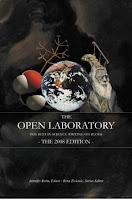 Science magazine last week featured a book review of the first volume of Emerging Model Organisms. Since this is what I hope Marmorkrebs to be, I looked at this with great interest. And luckily, author Jonathan Slack did make some instructive comments on what makes for a successful model organism.
Science magazine last week featured a book review of the first volume of Emerging Model Organisms. Since this is what I hope Marmorkrebs to be, I looked at this with great interest. And luckily, author Jonathan Slack did make some instructive comments on what makes for a successful model organism.A model organism must exemplify some key general biological problem that can be solved relatively easily with it and that will turn out to have the same answer for more important but experimentally less tractable organisms, namely human beings or economically important domestic animals and crop plants.
Because I’m a neurobiologist, my opinion may be skewed, but it seems to me that crayfish serve well for general biological problems related to nervous system organization and function, as I hope I show my irregular series, “Great Moments in Crayfish Research.” So, in a sense, Marmorkrebs is not entirely a new model organism, but a variation that can take advantage of new questions (e.g., evo-devo) and methodologies (e.g., transgenics). Marmorkrebs do also serve as a model for “economically important animals,” namely other large decapod crustaceans like lobsters and crayfish, whose rearing is less convenient.
The book's protocols reveal that not all the aspirant models are capable of being bred in the lab—something I would consider a basic requirement.
And that’s a point in Marmorkrebs favour, though I’ll be the first to admit that the fairly long generation time and a few related concerns are issues.
For those who manage science funding, the book should pose the question: How many model organisms do we need? That issue is all the more urgent because there is a second volume of this series looming, so there will soon be another 20 or so organisms wanting to get their snouts, tentacles, probosci, or roots into the trough. We practitioners of academic life sciences feel we require a doubling of total expenditure about every five years to remain reasonably comfortable. Funding bodies have found this a difficult target to meet, and it will become even harder with so many more model organisms to feed.
I added the emphasis, because the statement is one that I have never seen before. It’s not clear to me if he’s talking about individual researchers, a research lab, a research field, or something else. But I’ll take a stab at replying to Slack’s rhetorical question with one of my own.
How many more Drosophila researchers do we need? Or mouse? Or C. elegans? Or E. coli?
Now, I am not criticizing anyone who works on those organisms. I know a lot of those people, and I like a lot of those people, and appreciate the science that they do. But the recruitment of researchers to existing model organisms resembles what Jorge Cham called a “Profzi scheme,” where more and more people are working on fewer and fewer organisms.
Perhaps a lesson can be taken from ecology rather than economy. In ecology, it’s often the case that there are advantages to being rare.
References
Slack JMW. 2009. Emerging market organisms. Science 323(5922): 1674-1675. doi: 10.1126/science.1171948
Various authors. 2009. Emerging Model Organisms, A Laboratory Manual, Volume 1.
Cold Spring Harbor Laboratory Press, Cold Spring Harbor, NY. ISBN 9780879698263. ISBN 9780879698720. http://cshprotocols.cshlp.org/emo/















